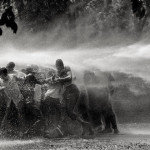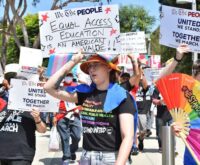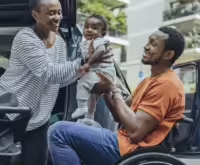| By Daniel Kraker, VoA News
Kayenta, Arizona – April 5, 2005 – Native Americans are more likely than any other ethnic group in the country to have a physical disability. That’s mainly due to high rates of alcoholism and diabetes. And on remote reservations like Pine Ridge, in South Dakota, and the Navajo Nation, in Arizona, people in wheelchairs – like Darlene Singer – face challenges not seen in other parts of the country. Her modest house on the Navajo Nation is 5 kilometers from the nearest paved road, more than 30 from the closest town. This is high desert country. The quiet hangs thick in the cold air… broken only by the occasional bark of a stray dog Ms. Singer’s nephew has rescued. But inside, a wood stove keeps the house snug. Darlene Singer sits in her wheelchair at the kitchen table after a lunch of spaghetti and fry bread. Eighteen years ago, a car accident left her a paraplegic, and her sister Doris a quadriplegic. Doris’s newborn baby was killed. Ms. Singer moved back home. She likes living here with her mom, but admits things could be better. “What I really need out here is a phone line,” she says, noting that the main line it would hook up with is more than 3 kilometers away. “I applied for it but the phone company told me I had to pay out of my own pocket.” She has a cell phone, but doesn’t get reception at her house. A phone can mean the difference between life and death. Two years ago, Ms. Singer was home alone shortly after bladder surgery, when her incision re-opened. “I didn’t know what was going on,” she recalls. “It was bleeding, draining. So I just laid back down.” Luckily her uncle dropped by and drove to a relative’s house to call an ambulance. Such hardships are not uncommon on remote reservations. Ellen Rothman, who works for the Indian Health Service on the Navajo Nation, says “when day to day life is so hard, disability issues are just under the radar.” When she arrived on the reservation four years ago, fresh out of Harvard Medical School, she was shocked by how the ‘average’ person lived. “No running water, no electricity, no phone, when you’re in a wheelchair, it’s just really unbelievable, and it’s unbelievable that something like this exists in the United States.” It exists in part because tribal sovereignty exempts the Navajo Nation and other tribes from the Americans with Disabilities Act, which requires all public buildings and transportation be accessible to wheelchairs. That’s not to say the estimated 10% of Navajos with physical disabilities have to fend completely for themselves. The Indian Health Service provides medical care for all Native Americans. And state governments arrange for in-home services, transportation and equipment for those who can’t afford it. But Dr. Rothman says just having the basics isn’t enough to help the disabled participate in life. “I think up to this point a lot of them were living at home,” she says, “and [were] really isolated there either by [a lack of] transportation or fear of what the community was going to think of them when they came out.” That isolation can lead to depression. So Dr. Rothman began looking around for popular activities that could be made accessible to people in wheelchairs. She raised money for 10 athletic chairs and the Mustangs Wheelchair Basketball Team was born. Earlier this year, they made their debut at a high school basketball game in Kayenta, near the Utah border. At halftime, in front of more than 2,000 fans, the team rolled on to the court. To wild cheers and applause, they passed the ball back and forth, before tossing it into the basket. After about 5 minutes of showing off for the crowd, Gleave Isaac was buzzing with excitement. “With all the cheering, with all the support from the audience, a good turnout, all my nerves, my butterflies just went away. It was fantastic,” he said, spinning his chair around. “It was fantastic. I loved it. I’m sure some people are already looking forward to seeing us out there again someday on the court.” He’s also encouraged by off-the-court developments. He and his teammates now attend monthly support group meetings. They have gone swimming, downhill skiing and whitewater rafting. Michael Blatchford, who directs the reservation’s only independent living center for people with disabilities, is pushing the Navajo Nation to make buildings more accessible. He says tribal governments are slowly growing more sensitive to disabilities, and he’s hopeful about the future. “I’m hoping 5, 10, 20 years down the road, it will be accessible where people don’t have to pick and choose where they go, they don’t have to say, oh, I can only go here because the doors are wide enough, and that’s the only place I can eat because the tables are high enough.” And when that’s done, Mr. Blatchford says, he’d like to get rid of the labels. Instead of being known as a paraplegic, or that guy in the wheelchair, he wants to be known, simply, as Michael Blatchford.
Hear the AudioDaniel Kraker report–download (mp3)
Credit: This article originally appeared on the Voice of America web site athttp://voanews.com and was broadcast on VoA radio |
||
|











